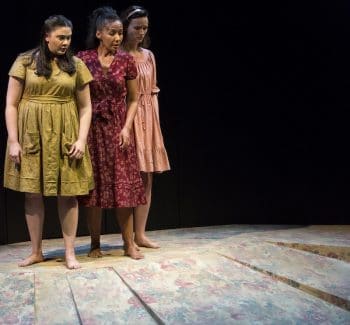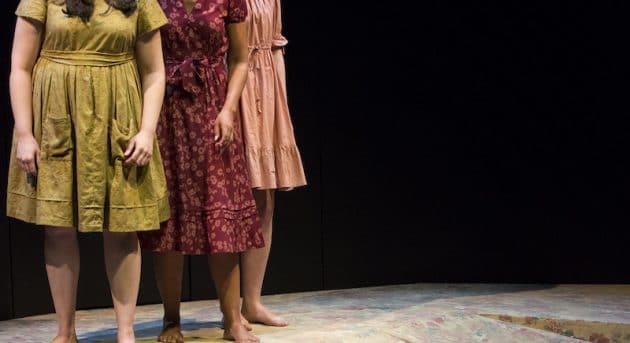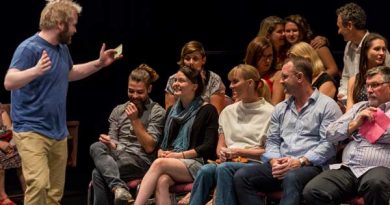The Bleeding Tree – Wharf Theatre, STC
As the lights come down on The Bleeding Tree, silence momentarily consumes the audience. From the first moment, this play demands every ounce of your attention and emotional investment. It’s only as it draws to a close that we are able to fully process what we just witnessed.
The play opens on three women: a mother (Paula Arundell), and her two daughters (Airlie Dodds and Shari Sebbens). They have just killed their husband and father. He was drunk, as usual, and ready to unleash his “fists like molten rain,” as usual.
The story unfolds from there, told in the present tense as the women grapple with the ramifications of what they’ve done. We watch as they dispose of the body, constantly fearful of prying neighbours – and we watch those same neighbours ultimately give the family their sympathies and support. It seems the whole town knew the extent of the suffering the women have endured.

Renee Mulder’s minimalistic yet evocative set defines the parameters of the action; its pattern and colours evoke rural Australian life. When aided by Verity Hampson’s lighting and Steve Toulmin’s soundscape, it is easy to forget we’re not on a farm in the middle of a dry summer’s day.
The play, by Melbourne playwright Angus Cerini, first premiered at Griffin Theatre Company in August 2015. It went on to collect numerous awards, including the Helpmann Award for Best Play and Sydney Theatre Award for Best New Australian Work. It’s easy to see why.
Cerini’s fast paced and dense script is poetic in its pace and style. He weaves the lives of these characters – their memories, fears, and hopes – into sharp, overlapping dialogue that sometimes disorients, but reveals magnitudes about the lives these women have led. His dialogue is brutally honest and vulnerable, yet also manages to weave humour and lightness very naturally into a chillingly dark context.
Lee Lewis’ nuanced direction both haunts our conscience and confronts us with the depths of the play’s horrors and the extent of these women’s despair, and yet balances the sombre tone with Cerini’s cleverly-placed, tricky to deploy lighter moments that allow, somewhat miraculously, for a resounding sense of hope.
Paula Arundell is astonishing as the mother desperately trying to protect her children and wife finally free of years of unbelievable torment. Her vulnerable performance captivates from start to finish, entwining us in the unfolding of her anxieties, and memories, along with her renewed hope for a brighter future. We feel the ramifications with her as she both rejoices and recoils from what she has done.
Dodds and Sebbens are just as engrossing in their performances. Dodds brings an endearing innocence to the role; she is riddled by guilt and longs to do good, yet is so relieved to be free from years of anguish. Sebbens balances the dichotomy inherent in being a naïve child who has been forced to grow up far too quickly; she is both mature and strong, and fully aware of the ramifications of her actions, but still a hurting and confused child. All three women take on the dialogue of other characters as they appear throughout the play with detail and versatility; you almost forget there are only three bodies on the stage.
The Bleeding Tree shines a light on some of the darkest parts of our society, and as we see three women tackle the realities of domestic violence onstage, it’s harrowing to witness. The Bleeding Tree confronts us with an ugly story – the story of many women across Australia – and, knowing some women die before breaking free from their abuser, it’s difficult to leave the theatre and quickly forget it.




